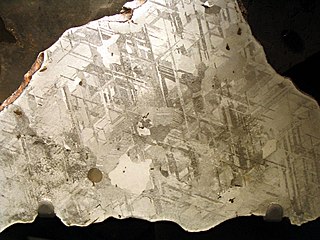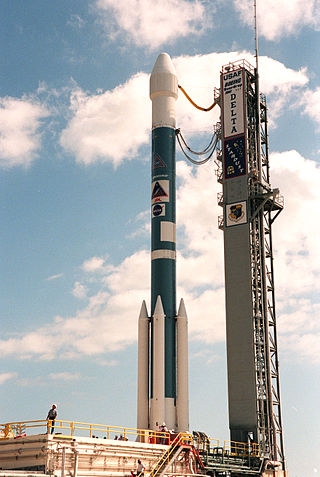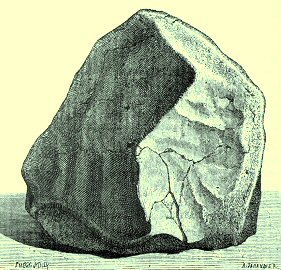
Kamacite is an alloy of iron and nickel, which is found on Earth only in meteorites. According to the International Mineralogical Association (IMA) it is considered a proper nickel-rich variety of the mineral native iron. The proportion iron:nickel is between 90%:10% and 95%:5%; small quantities of other elements, such as cobalt or carbon may also be present. The mineral has a metallic luster, is gray and has no clear cleavage although its crystal structure is isometric-hexoctahedral. Its density is about 8 g/cm3 and its hardness is 4 on the Mohs scale. It is also sometimes called balkeneisen.

Presolar grains are interstellar solid matter in the form of tiny solid grains that originated at a time before the Sun was formed. Presolar stardust grains formed within outflowing and cooling gases from earlier presolar stars.

A chondrite is a stony (non-metallic) meteorite that has not been modified, by either melting or differentiation of the parent body. They are formed when various types of dust and small grains in the early Solar System accreted to form primitive asteroids. Some such bodies that are captured in the planet's gravity well become the most common type of meteorite by arriving on a trajectory toward the planet's surface. Estimates for their contribution to the total meteorite population vary between 85.7% and 86.2%.

A micrometeorite is a micrometeoroid that has survived entry through the Earth's atmosphere. Usually found on Earth's surface, micrometeorites differ from meteorites in that they are smaller in size, more abundant, and different in composition. The IAU officially defines meteorites as 30 micrometers to 1 meter; micrometeorites are the small end of the range (~submillimeter). They are a subset of cosmic dust, which also includes the smaller interplanetary dust particles (IDPs).

Orgueil is a scientifically important carbonaceous chondrite meteorite that fell in southwestern France in 1864.
The Paul Pellas-Graham Ryder Award is jointly sponsored by the Meteoritical Society and the Planetary Geology Division of the Geological Society of America. It recognizes the best planetary science paper, published during the previous year in a peer-reviewed scientific journal, and written by an undergraduate or graduate student. The topics covered by the award are listed on the cover of Meteoritics and Planetary Science. It has been given since 2002, and honors the memories of the incomparable meteoriticist Paul Pellas and lunar scientist Graham Ryder.

The Lunar Magma Ocean (LMO) is the layer of molten rock that is theorized to have been present on the surface of the Moon. The Lunar Magma Ocean was likely present on the Moon from the time of the Moon's formation to tens or hundreds of millions years after that time. It is a thermodynamic consequence of the Moon's relatively rapid formation in the aftermath of a giant impact between the proto-Earth and another planetary body. As the Moon accreted from the debris from the giant impact, gravitational potential energy was converted to thermal energy. Due to the rapid accretion of the Moon, thermal energy was trapped since it did not have sufficient time to thermally radiate away energy through the lunar surface. The subsequent thermochemical evolution of the Lunar Magma Ocean explains the Moon's largely anorthositic crust, europium anomaly, and KREEP material.

In geochemistry, the primitive mantle is the chemical composition of the Earth's mantle during the developmental stage between core-mantle differentiation and the formation of early continental crust. The chemical composition of the primitive mantle contains characteristics of both the crust and the mantle.
CI chondrites, also called C1 chondrites or Ivuna-type carbonaceous chondrites, are a group of rare carbonaceous chondrite, a type of stony meteorite. They are named after the Ivuna meteorite, the type specimen. CI chondrites have been recovered in France, Canada, India, and Tanzania. Their overall chemical composition closely resembles the elemental composition of the Sun, more so than any other type of meteorite.
Winonaites are a group of primitive achondrite meteorites. Like all primitive achondrites, winonaites share similarities with chondrites and achondrites. They show signs of metamorphism, partial melting, brecciation and relic chondrules. Their chemical and mineralogical composition lies between H and E chondrites.

IVB meteorites are a group of ataxite iron meteorites classified as achondrites. The IVB group has the most extreme chemical compositions of all iron meteorites, meaning that examples of the group are depleted in volatile elements and enriched in refractory elements compared to other iron meteorites.
This is a glossary of terms used in meteoritics, the science of meteorites.
Robert Norman Clayton was a Canadian-American chemist and academic. He was the Enrico Fermi Distinguished Service Professor Emeritus of Chemistry at the University of Chicago. Clayton studied cosmochemistry and held a joint appointment in the university's geophysical sciences department. He was a member of the National Academy of Sciences and was named a fellow of several academic societies, including the Royal Society.

Toshiko K. Mayeda was a Japanese American chemist who worked at the Enrico Fermi Institute in the University of Chicago. She worked on climate science and meteorites from 1958 to 2004.
Asteroidal water is water or water precursor deposits such as hydroxide (OH−) that exist in asteroids. The "snow line" of the Solar System lies outside of the main asteroid belt, and the majority of water is expected in minor planets. Nevertheless, a significant amount of water is also found inside the snow line, including in near-earth objects (NEOs).
CM chondrites are a group of chondritic meteorites which resemble their type specimen, the Mighei meteorite. The CM is the most commonly recovered group of the 'carbonaceous chondrite' class of meteorites, though all are rarer in collections than ordinary chondrites.
Hafnium–tungsten dating is a geochronological radiometric dating method utilizing the radioactive decay system of hafnium-182 to tungsten-182. The half-life of the system is 8.9±0.1 million years. Today hafnium-182 is an extinct radionuclide, but the hafnium–tungsten radioactive system is useful in studies of the early Solar system since hafnium is lithophilic while tungsten is moderately siderophilic, which allows the system to be used to date the differentiation of a planet's core. It is also useful in determining the formation times of the parent bodies of iron meteorites.
Gas-rich meteorites are meteorites with high levels of primordial gases, such as helium, neon, argon, krypton, xenon and sometimes other elements. Though these gases are present "in virtually all meteorites," the Fayetteville meteorite has ~2,000,000 x10−8 ccSTP/g helium, or ~2% helium by volume equivalent. In comparison, background level is a few ppm.

Tonk is a small carbonaceous chondrite meteorite that fell near Tonk, India in 1911. Despite its small size, it is often included in studies due to its compositional similarity to the early solar system.
Xenon isotope geochemistry uses the abundance of xenon (Xe) isotopes and total xenon to investigate how Xe has been generated, transported, fractionated, and distributed in planetary systems. Xe has nine stable or very long-lived isotopes. Radiogenic 129Xe and fissiogenic 131,132,134,136Xe isotopes are of special interest in geochemical research. The radiogenic and fissiogenic properties can be used in deciphering the early chronology of Earth. Elemental Xe in the atmosphere is depleted and isotopically enriched in heavier isotopes relative to estimated solar abundances. The depletion and heavy isotopic enrichment can be explained by hydrodynamic escape to space that occurred in Earth's early atmosphere. Differences in the Xe isotope distribution between the deep mantle, shallower Mid-ocean Ridge Basalts (MORBs), and the atmosphere can be used to deduce Earth's history of formation and differentiation of the solid Earth into layers.









